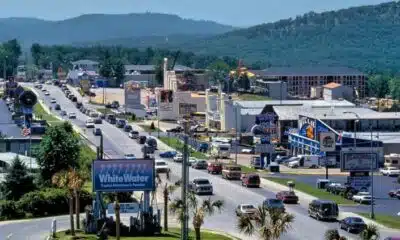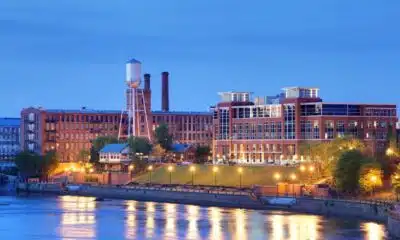Kaiser Health News
Using Opioid Settlement Cash for Police Gear Like Squad Cars and Scanners Sparks Debate
Aneri Pattani
Mon, 23 Oct 2023 09:00:00 +0000
Policing expenses mount quickly: $25,000 for a law enforcement conference about fentanyl in Colorado; $18,000 for technology to unlock cellphones in Southington, Connecticut; $2,900 for surveillance cameras and to train officers and canines in New Lexington, Ohio. And in other communities around the country, hundreds of thousands for vehicles, body scanners, and other equipment.
In these cases and many others, state and local governments are turning to a new means to pay those bills: opioid settlement cash.
This money — totaling more than $50 billion across 18 years — comes from national settlements with more than a dozen companies that made, sold, or distributed opioid painkillers, including Johnson & Johnson, AmerisourceBergen, and Walmart, which were accused of fueling the epidemic that addicted and killed millions.
Directing the funds to police has triggered difficult questions about what the money was meant for and whether such spending truly helps save lives.
Terms vary slightly across settlements, but, in most cases, state and local governments must spend at least 85% of the cash on “opioid remediation.”
Paving roads or building schools is out of the question. But if a new cruiser helps officers reach the scene of an overdose, does that count?
Answers are being fleshed out in real time.
The money shouldn’t be spent on “things that have never really made a difference,” like arresting low-level drug dealers or throwing people in jail when they need treatment, said Brandon del Pozo, who served as a police officer for 23 years and is currently an assistant professor at Brown University researching policing and public health. At the same time, “you can’t just cut the police out of it. Nor would you want to.”
Many communities are finding it difficult to thread that needle. With fentanyl, a powerful synthetic opioid, flooding the streets and more than 100,000 Americans dying of overdoses each year, some people argue that efforts to crack down on drug trafficking warrant law enforcement spending. Others say their war on drugs failed and it’s time to emphasize treatment and social services. Then there are local officials who recognize the limits of what police and jails can do to stop addiction but see them as the only services in town.
What’s clear is that each decision — whether to fund a treatment facility or buy a squad car — is a trade-off. The settlements will deliver billions of dollars, but that windfall is dwarfed by the toll of the epidemic. So increasing funding for one approach means shortchanging another.
“We need to have a balance when it comes to spending opioid settlement funds,” said Patrick Patterson, vice chair of Michigan’s Opioid Advisory Commission, who is in recovery from opioid addiction. If a county funds a recovery coach inside the jail, but no recovery services in the community, then “where is that recovery coach going to take people upon release?” he asked.
Jail Technology Upgrades?
In Michigan, the debate over where to spend the money centers on body scanners for jails.
Email records obtained by KFF Health News show at least half a dozen sheriff departments discussed buying them with opioid settlement funds.
Kalamazoo County finalized its purchase in July: an Intercept body scanner marketed as a “next-generation” screening tool to help jails detect contraband someone might smuggle under clothing or inside their bodies. It takes a full-body X-ray in 3.8 seconds, the company website says. The price tag is close to $200,000.
Jail administrator and police Capt. Logan Bishop said they bought it because in 2016 a 26-year-old man died inside the jail after drug-filled balloons he’d hidden inside his body ruptured. And last year, staffers saved a man who was overdosing on opioids he’d smuggled in. In both cases, officers hadn’t found the drugs, but the scanner might have identified them, Bishop said.
“The ultimate goal is to save lives,” he added.
St. Clair County also approved the purchase of a scanner with settlement dollars. Jail administrator Tracy DeCaussin said six people overdosed inside the jail within the past year. Though they survived, the scanner would enhance “the safety and security of our facility.”
But at least three other counties came to a different decision.
“Our county attorney read over parameters of the settlement’s allowable expenses, and his opinion was that it would not qualify,” said Sheriff Kyle Rosa of Benzie County. “So we had to hit the brakes” on the scanner.
Macomb and Manistee counties used alternative funds to buy the devices.
Scanners are a reasonable purchase from a county’s general funds, said Matthew Costello, who worked at a Detroit jail for 29 years and now helps jails develop addiction treatment programs as part of Wayne State University’s Center for Behavioral Health and Justice.
After all, technology upgrades are “part and parcel of running a jail,” he said. But they shouldn’t be bought with opioid dollars because body scanners do “absolutely nothing to address substance use issues in jail other than potentially finding substances,” he said.
Many experts across the criminal justice and addiction treatment fields agree that settlement funds would be better spent increasing access to medications for opioid use disorder, which have been shown to save lives and keep people engaged in treatment longer, but are frequently absent from jail care.
Who Is on the Front Lines?
In August, more than 200 researchers and clinicians delivered a call to action to government officials in charge of opioid settlement funds.
“More policing is not the answer to the overdose crisis,” they wrote.
In fact, years of research suggests law enforcement and criminal justice initiatives have exacerbated the problem, they said. When officers respond to an overdose, they often arrest people. Fear of arrest can keep people from calling 911 in overdose emergencies. And even if police are accompanied by mental health professionals, people can be scared to engage with them and connect to treatment.
A study published this year linked seizures of opioids to a doubling of overdose deaths in the areas surrounding those seizures, as people turned to new dealers and unfamiliar drug supplies.
“Police activity is actually causing the very harms that police activity is supposed to be stemming,” said Jennifer Carroll, an author of that study and an addiction policy researcher who signed the call to action.
Officers are meant to enforce laws, not deliver public health interventions, she said. “The best thing that police can do is recognize that this is not their lane,” she added.
But if not police, who will fill that lane?
Rodney Stabler, chair of the board of commissioners in Bibb County, Alabama, said there are no specialized mental health treatment options nearby. When residents need care, they must drive 50 minutes to Birmingham. If they’re suicidal or in severe withdrawal, someone from the sheriff’s office will drive them.
So Stabler and other commissioners voted to spend about $91,000 of settlement funds on two Chevy pickups for the sheriff’s office.
“We’re going to have to have a dependable truck to do that,” he said.
Commissioners also approved $26,000 to outfit two new patrol vehicles with lights, sirens, and radios, and $5,500 to purchase roadside cameras that scan passing vehicles and flag wanted license plates.
Stabler said these investments support the county agencies that most directly deal with addiction-related issues: “I think we’re using it the right way. I really do.”
Shawn Bain, a retired captain of the Franklin County, Ohio, sheriff’s office, agrees.
“People need to look beyond, ‘Oh, it’s just a vest or it’s just a squad car,’ because those tools could impact and reduce drugs in their communities,” said Bain, who has more than 25 years of drug investigation experience. “That cruiser could very well stop the next guy with five kilos of cocaine,” and a vest “could save an officer’s life on the next drug raid.”
That’s not to say those tools are the solution, he added. They need to be paired with equally important education and prevention efforts, he said.
However, many advocates say the balance is off. Law enforcement has been well funded for years, while prevention and treatment efforts lag. As a result, law enforcement has become the de facto front line, even if they’re not well suited to it.
“If that’s the front lines, we’ve got to move the line,” said Elyse Stevens, a primary care doctor at University Medical Center New Orleans, who specializes in addiction. “By the time you’re putting someone in jail, you’ve missed 10,000 opportunities to help them.”
Stevens treats about 20 patients with substance use disorder daily and has appointments booked out two months. She skips lunch and takes patient calls after hours to meet the demand.
“The answer is treatment,” she said. “If we could just focus on treating the patient, I promise you all of this would disappear.”
Sheriffs to Be Paid Millions
In Louisiana, where Stevens works, 80% of settlement dollars are flowing to parish governments and 20% to sheriffs’ departments.
Over the lifetime of the settlements, sheriffs’ offices in the state will receive more than $65 million — the largest direct allocation to law enforcement nationwide.
And they do not have to account for how they spend it.
While parish governments must submit detailed annual expense reports to a statewide opioid task force, the state’s settlement agreement exempts sheriffs.
Louisiana Attorney General Jeff Landry, who authored that agreement and has since been elected governor, did not respond to questions about the discrepancy.
Chester Cedars, president of St. Martin parish and a member of the Louisiana Opioid Abatement Task Force, said he’s confident sheriffs will spend the money appropriately.
“I don’t see a whole lot of sheriffs trying to buy bullets and bulletproof vests,” he said. Most are “eager to find programs that will keep people with substance abuse problems out of their jails.”
Sheriffs are still subject to standard state audits and public records requests, he said.
But there’s room for skepticism.
“Why would you just give them a check” with nothing “to make sure it’s being used properly?” said Tonja Myles, a community activist and former military police officer who is in recovery from addiction. “Those are the kinds of things that mess with people’s trust.”
Still, Myles knows she has to work with law enforcement to address the crisis. She’s starting a pilot program with Baton Rouge police, in which trained people with personal addiction experience will accompany officers on overdose calls to connect people to treatment. East Baton Rouge Parish is funding the pilot with $200,000 of settlement funds.
“We have to learn how to coexist together in this space,” Myles said. “But everybody has to know their role.”
——————————
By: Aneri Pattani
Title: Using Opioid Settlement Cash for Police Gear Like Squad Cars and Scanners Sparks Debate
Sourced From: kffhealthnews.org/news/article/using-opioid-settlement-cash-for-police-gear-like-squad-cars-and-scanners-sparks-debate/
Published Date: Mon, 23 Oct 2023 09:00:00 +0000
Kaiser Health News
Dual Threats From Trump and GOP Imperil Nursing Homes and Their Foreign-Born Workers
In a top-rated nursing home in Alexandria, Virginia, the Rev. Donald Goodness is cared for by nurses and aides from various parts of Africa. One of them, Jackline Conteh, a naturalized citizen and nurse assistant from Sierra Leone, bathes and helps dress him most days and vigilantly intercepts any meal headed his way that contains gluten, as Goodness has celiac disease.
“We are full of people who come from other countries,” Goodness, 92, said about Goodwin House Alexandria’s staff. Without them, the retired Episcopal priest said, “I would be, and my building would be, desolate.”
The long-term health care industry is facing a double whammy from President Donald Trump’s crackdown on immigrants and the GOP’s proposals to reduce Medicaid spending. The industry is highly dependent on foreign workers: More than 800,000 immigrants and naturalized citizens comprise 28% of direct care employees at home care agencies, nursing homes, assisted living facilities, and other long-term care companies.
But in January, the Trump administration rescinded former President Joe Biden’s 2021 policy that protected health care facilities from Immigration and Customs Enforcement raids. The administration’s broad immigration crackdown threatens to drastically reduce the number of current and future workers for the industry. “People may be here on a green card, and they are afraid ICE is going to show up,” said Katie Smith Sloan, president of LeadingAge, an association of nonprofits that care for older adults.
Existing staffing shortages and quality-of-care problems would be compounded by other policies pushed by Trump and the Republican-led Congress, according to nursing home officials, resident advocates, and academic experts. Federal spending cuts under negotiation may strip nursing homes of some of their largest revenue sources by limiting ways states leverage Medicaid money and making it harder for new nursing home residents to retroactively qualify for Medicaid. Care for 6 in 10 residents is paid for by Medicaid, the state-federal health program for poor or disabled Americans.
“We are facing the collision of two policies here that could further erode staffing in nursing homes and present health outcome challenges,” said Eric Roberts, an associate professor of internal medicine at the University of Pennsylvania.
The industry hasn’t recovered from covid-19, which killed more than 200,000 long-term care facility residents and workers and led to massive staff attrition and turnover. Nursing homes have struggled to replace licensed nurses, who can find better-paying jobs at hospitals and doctors’ offices, as well as nursing assistants, who can earn more working at big-box stores or fast-food joints. Quality issues that preceded the pandemic have expanded: The percentage of nursing homes that federal health inspectors cited for putting residents in jeopardy of immediate harm or death has risen alarmingly from 17% in 2015 to 28% in 2024.
In addition to seeking to reduce Medicaid spending, congressional Republicans have proposed shelving the biggest nursing home reform in decades: a Biden-era rule mandating minimum staffing levels that would require most of the nation’s nearly 15,000 nursing homes to hire more workers.
The long-term care industry expects demand for direct care workers to burgeon with an influx of aging baby boomers needing professional care. The Census Bureau has projected the number of people 65 and older would grow from 63 million this year to 82 million in 2050.
In an email, Vianca Rodriguez Feliciano, a spokesperson for the Department of Health and Human Services, said the agency “is committed to supporting a strong, stable long-term care workforce” and “continues to work with states and providers to ensure quality care for older adults and individuals with disabilities.” In a separate email, Tricia McLaughlin, a Department of Homeland Security spokesperson, said foreigners wanting to work as caregivers “need to do that by coming here the legal way” but did not address the effect on the long-term care workforce of deportations of classes of authorized immigrants.
Goodwin Living, a faith-based nonprofit, runs three retirement communities in northern Virginia for people who live independently, need a little assistance each day, have memory issues, or require the availability of around-the-clock nurses. It also operates a retirement community in Washington, D.C. Medicare rates Goodwin House Alexandria as one of the best-staffed nursing homes in the country. Forty percent of the organization’s 1,450 employees are foreign-born and are either seeking citizenship or are already naturalized, according to Lindsay Hutter, a Goodwin spokesperson.
“As an employer, we see they stay on with us, they have longer tenure, they are more committed to the organization,” said Rob Liebreich, Goodwin’s president and CEO.
Jackline Conteh spent much of her youth shuttling between Sierra Leone, Liberia, and Ghana to avoid wars and tribal conflicts. Her mother was killed by a stray bullet in her home country of Liberia, Conteh said. “She was sitting outside,” Conteh, 56, recalled in an interview.
Conteh was working as a nurse in a hospital in Sierra Leone in 2009 when she learned of a lottery for visas to come to the United States. She won, though she couldn’t afford to bring her husband and two children along at the time. After she got a nursing assistant certification, Goodwin hired her in 2012.
Conteh said taking care of elders is embedded in the culture of African families. When she was 9, she helped feed and dress her grandmother, a job that rotated among her and her sisters. She washed her father when he was dying of prostate cancer. Her husband joined her in the United States in 2017; she cares for him because he has heart failure.
“Nearly every one of us from Africa, we know how to care for older adults,” she said.
Her daughter is now in the United States, while her son is still in Africa. Conteh said she sends money to him, her mother-in-law, and one of her sisters.
In the nursing home where Goodness and 89 other residents live, Conteh helps with daily tasks like dressing and eating, checks residents’ skin for signs of swelling or sores, and tries to help them avoid falling or getting disoriented. Of 102 employees in the building, broken up into eight residential wings called “small houses” and a wing for memory care, at least 72 were born abroad, Hutter said.
Donald Goodness grew up in Rochester, New York, and spent 25 years as rector of The Church of the Ascension in New York City, retiring in 1997. He and his late wife moved to Alexandria to be closer to their daughter, and in 2011 they moved into independent living at the Goodwin House. In 2023 he moved into one of the skilled nursing small houses, where Conteh started caring for him.
“I have a bad leg and I can’t stand on it very much, or I’d fall over,” he said. “She’s in there at 7:30 in the morning, and she helps me bathe.” Goodness said Conteh is exacting about cleanliness and will tell the housekeepers if his room is not kept properly.
Conteh said Goodness was withdrawn when he first arrived. “He don’t want to come out, he want to eat in his room,” she said. “He don’t want to be with the other people in the dining room, so I start making friends with him.”
She showed him a photo of Sierra Leone on her phone and told him of the weather there. He told her about his work at the church and how his wife did laundry for the choir. The breakthrough, she said, came one day when he agreed to lunch with her in the dining room. Long out of his shell, Goodness now sits on the community’s resident council and enjoys distributing the mail to other residents on his floor.
“The people that work in my building become so important to us,” Goodness said.
While Trump’s 2024 election campaign focused on foreigners here without authorization, his administration has broadened to target those legally here, including refugees who fled countries beset by wars or natural disasters. This month, the Department of Homeland Security revoked the work permits for migrants and refugees from Cuba, Haiti, Nicaragua, and Venezuela who arrived under a Biden-era program.
“I’ve just spent my morning firing good, honest people because the federal government told us that we had to,” Rachel Blumberg, president of the Toby & Leon Cooperman Sinai Residences of Boca Raton, a Florida retirement community, said in a video posted on LinkedIn. “I am so sick of people saying that we are deporting people because they are criminals. Let me tell you, they are not all criminals.”
At Goodwin House, Conteh is fearful for her fellow immigrants. Foreign workers at Goodwin rarely talk about their backgrounds. “They’re scared,” she said. “Nobody trusts anybody.” Her neighbors in her apartment complex fled the U.S. in December and returned to Sierra Leone after Trump won the election, leaving their children with relatives.
“If all these people leave the United States, they go back to Africa or to their various countries, what will become of our residents?” Conteh asked. “What will become of our old people that we’re taking care of?”
KFF Health News is a national newsroom that produces in-depth journalism about health issues and is one of the core operating programs at KFF—an independent source of health policy research, polling, and journalism. Learn more about KFF.
Subscribe to KFF Health News’ free Morning Briefing.
This article first appeared on KFF Health News and is republished here under a Creative Commons license.
The post Dual Threats From Trump and GOP Imperil Nursing Homes and Their Foreign-Born Workers appeared first on kffhealthnews.org
Note: The following A.I. based commentary is not part of the original article, reproduced above, but is offered in the hopes that it will promote greater media literacy and critical thinking, by making any potential bias more visible to the reader –Staff Editor.
Political Bias Rating: Center-Left
This content primarily highlights concerns about the impact of restrictive immigration policies and Medicaid spending cuts proposed by the Trump administration and Republican lawmakers on the long-term care industry. It emphasizes the importance of immigrant workers in healthcare, the challenges that staffing shortages pose to patient care, and the potential negative effects of GOP policy proposals. The tone is critical of these policies while sympathetic toward immigrant workers and advocates for maintaining or increasing government support for healthcare funding. The framing aligns with a center-left perspective, focusing on social welfare, immigrant rights, and concern about the consequences of conservative economic and immigration policies without descending into partisan rhetoric.
Kaiser Health News
California’s Much-Touted IVF Law May Be Delayed Until 2026, Leaving Many in the Lurch
California lawmakers are poised to delay the state’s much-ballyhooed new law mandating in vitro fertilization insurance coverage for millions, set to take effect July 1. Gov. Gavin Newsom has asked lawmakers to push the implementation date to January 2026, leaving patients, insurers, and employers in limbo.
The law, SB 729, requires state-regulated health plans offered by large employers to cover infertility diagnosis and treatment, including IVF. Nine million people will qualify for coverage under the law. Advocates have praised the law as “a major win for Californians,” especially in making same-sex couples and aspiring single parents eligible, though cost concerns limited the mandate’s breadth.
People who had been planning fertility care based on the original timeline are now “left in a holding pattern facing more uncertainty, financial strain, and emotional distress,” Alise Powell, a director at Resolve: The National Infertility Association, said in a statement.
During IVF, a patient’s eggs are retrieved, combined with sperm in a lab, and then transferred to a person’s uterus. A single cycle can total around $25,000, out of reach for many. The California law requires insurers to cover up to three egg retrievals and an unlimited number of embryo transfers.
Not everyone’s coverage would be affected by the delay. Even if the law took effect July 1, it wouldn’t require IVF coverage to start until the month an employer’s contract renews with its insurer. Rachel Arrezola, a spokesperson for the California Department of Managed Health Care, said most of the employers subject to the law renew their contracts in January, so their employees would not be affected by a delay.
She declined to provide data on the percentage of eligible contracts that renew in July or later, which would mean those enrollees wouldn’t get IVF coverage until at least a full year from now, in July 2026 or later.
The proposed new implementation date comes amid heightened national attention on fertility coverage. California is now one of 15 states with an IVF mandate, and in February, President Donald Trump signed an executive order seeking policy recommendations to expand IVF access.
It’s the second time Newsom has asked lawmakers to delay the law. When the Democratic governor signed the bill in September, he asked the legislature to consider delaying implementation by six months. The reason, Newsom said then, was to allow time to reconcile differences between the bill and a broader effort by state regulators to include IVF and other fertility services as an essential health benefit, which would require the marketplace and other individual and small-group plans to provide the coverage.
Newsom spokesperson Elana Ross said the state needs more time to provide guidance to insurers on specific services not addressed in the law to ensure adequate and uniform coverage. Arrezola said embryo storage and donor eggs and sperm were examples of services requiring more guidance.
State Sen. Caroline Menjivar, a Democrat who authored the original IVF mandate, acknowledged a delay could frustrate people yearning to expand their families, but requested patience “a little longer so we can roll this out right.”
Sean Tipton, a lobbyist for the American Society for Reproductive Medicine, contended that the few remaining questions on the mandate did not warrant a long delay.
Lawmakers appear poised to advance the delay to a vote by both houses of the legislature, likely before the end of June. If a delay is approved and signed by the governor, the law would immediately be paused. If this does not happen before July 1, Arrezola said, the Department of Managed Health Care would enforce the mandate as it exists. All plans were required to submit compliance filings to the agency by March. Arrezola was unable to explain what would happen to IVF patients whose coverage had already begun if the delay passes after July 1.
The California Association of Health Plans, which opposed the mandate, declined to comment on where implementation efforts stand, although the group agrees that insurers need more guidance, spokesperson Mary Ellen Grant said.
Kaiser Permanente, the state’s largest insurer, has already sent employers information they can provide to their employees about the new benefit, company spokesperson Kathleen Chambers said. She added that eligible members whose plans renew on or after July 1 would have IVF coverage if implementation of the law is not delayed.
Employers and some fertility care providers appear to be grappling over the uncertainty of the law’s start date. Amy Donovan, a lawyer at insurance brokerage and consulting firm Keenan & Associates, said the firm has fielded many questions from employers about the possibility of delay. Reproductive Science Center and Shady Grove Fertility, major clinics serving different areas of California, posted on their websites that the IVF mandate had been delayed until January 2026, which is not yet the case. They did not respond to requests for comment.
Some infertility patients confused over whether and when they will be covered have run out of patience. Ana Rios and her wife, who live in the Central Valley, had been trying to have a baby for six years, dipping into savings for each failed treatment. Although she was “freaking thrilled” to learn about the new law last fall, Rios could not get clarity from her employer or health plan on whether she was eligible for the coverage and when it would go into effect, she said. The couple decided to go to Mexico to pursue cheaper treatment options.
“You think you finally have a helping hand,” Rios said of learning about the law and then, later, the requested delay. “You reach out, and they take it back.”
This article was produced by KFF Health News, which publishes California Healthline, an editorially independent service of the California Health Care Foundation.
KFF Health News is a national newsroom that produces in-depth journalism about health issues and is one of the core operating programs at KFF—an independent source of health policy research, polling, and journalism. Learn more about KFF.
USE OUR CONTENT
This story can be republished for free (details).
KFF Health News is a national newsroom that produces in-depth journalism about health issues and is one of the core operating programs at KFF—an independent source of health policy research, polling, and journalism. Learn more about KFF.
Subscribe to KFF Health News’ free Morning Briefing.
This article first appeared on KFF Health News and is republished here under a Creative Commons license.
The post California’s Much-Touted IVF Law May Be Delayed Until 2026, Leaving Many in the Lurch appeared first on kffhealthnews.org
Note: The following A.I. based commentary is not part of the original article, reproduced above, but is offered in the hopes that it will promote greater media literacy and critical thinking, by making any potential bias more visible to the reader –Staff Editor.
Political Bias Rating: Center-Left
This content is presented in a factual, balanced manner typical of center-left public policy reporting. It focuses on a progressive healthcare issue (mandated IVF insurance coverage) favorably highlighting benefits for diverse family structures and individuals, including same-sex couples and single parents, which often aligns with center-left values. At the same time, it includes perspectives from government officials, industry representatives, opponents, and patients, offering a nuanced view without overt ideological framing or partisan rhetoric. The emphasis on healthcare access, social equity, and patient impact situates the coverage within a center-left orientation.
Kaiser Health News
Push To Move OB-GYN Exam Out of Texas Is Piece of AGs’ Broader Reproductive Rights Campaign
Democratic state attorneys general led by those from California, New York, and Massachusetts are pressuring medical professional groups to defend reproductive rights, including medication abortion, emergency abortions, and travel between states for health care in response to recent increases in the number of abortion bans.
The American Medical Association adopted a formal position June 9 recommending that medical certification exams be moved out of states with restrictive abortion policies or made virtual, after 20 attorneys general petitioned to protect physicians who fear legal repercussions because of their work. The petition focused on the American Board of Obstetrics and Gynecology’s certification exams in Dallas, and the subsequent AMA recommendation was hailed as a win for Democrats trying to regain ground after the fall of Roe v. Wade.
“It seems incremental, but there are so many things that go into expanding and maintaining access to care,” said Arneta Rogers, executive director of the Center on Reproductive Rights and Justice at the University of California-Berkeley’s law school. “We see AGs banding together, governors banding together, as advocates work on the ground. That feels somewhat more hopeful — that people are thinking about a coordinated strategy.”
Since the Supreme Court eliminated the constitutional right to an abortion in 2022, 16 states, including Texas, have implemented laws banning abortion almost entirely, and many of them impose criminal penalties on providers as well as options to sue doctors. More than 25 states restrict access to gender-affirming care for trans people, and six of them make it a felony to provide such care to youth.
That’s raised concern among some physicians who fear being charged if they go to those states, even if their home state offers protection to provide reproductive and gender-affirming health care.
Pointing to the recent fining and indictment of a physician in New York who allegedly provided abortion pills to a woman in Texas and a teen in Louisiana, a coalition of physicians wrote in a letter to the American Board of Obstetrics and Gynecology that “the limits of shield laws are tenuous” and that “Texas laws can affect physicians practicing outside of the state as well.”
The campaign was launched by several Democratic attorneys general, including Rob Bonta of California, Andrea Joy Campbell of Massachusetts, and Letitia James of New York, who each have established a reproductive rights unit as a bulwark for their state following the Dobbs decision.
“Reproductive health care and gender-affirming care providers should not have to risk their safety or freedom just to advance in their medical careers,” James said in a statement. “Forcing providers to travel to states that have declared war on reproductive freedom and LGBTQ+ rights is as unnecessary as it is dangerous.”
In their petition, the attorneys general included a letter from Joseph Ottolenghi, medical director at Choices Women’s Medical Center in New York City, who was denied his request to take the test remotely or outside of Texas. To be certified by the American Board of Obstetrics and Gynecology, physicians need to take the in-person exam at its testing facility in Dallas. The board completed construction of its new testing facility last year.
“As a New York practitioner, I have made every effort not to violate any other state’s laws, but the outer contours of these draconian laws have not been tested or clarified by the courts,” Ottolenghi wrote.
Rachel Rebouché, the dean of Temple University’s law school and a reproductive law scholar, said “putting the heft” of the attorneys general behind this effort helps build awareness and a “public reckoning” on behalf of providers. Separately, some doctors have urged medical conferences to boycott states with abortion bans.
Anti-abortion groups, however, see the campaign as forcing providers to conform to abortion-rights views. Donna Harrison, an OB-GYN and the director of research at the American Association of Pro-Life Obstetricians and Gynecologists, described the petition as an “attack not only on pro-life states but also on life-affirming medical professionals.”
Harrison said the “OB-GYN community consists of physicians with values that are as diverse as our nation’s state abortion laws,” and that this diversity “fosters a medical environment of debate and rigorous thought leading to advancements that ultimately serve our patients.”
The AMA’s new policy urges specialty medical boards to host exams in states without restrictive abortion laws, offer the tests remotely, or provide exemptions for physicians. However, the decision to implement any changes to the administration of these exams is up to those boards. There is no deadline for a decision to be made.
The OB-GYN board did not respond to requests for comment, but after the public petition from the attorneys general criticizing it for refusing exam accommodations, the board said that in-person exams conducted at its national center in Dallas “provide the most equitable, fair, secure, and standardized assessment.”
The OB-GYN board emphasized that Texas’ laws apply to doctors licensed in Texas and to medical care within Texas, specifically. And it noted that its exam dates are kept under wraps, and that there have been “no incidents of harm to candidates or examiners across thousands of in-person examinations.”
Democratic state prosecutors, however, warned in their petition that the “web of confusing and punitive state-based restrictions creates a legal minefield for medical providers.” Texas is among the states that have banned doctors from providing gender-affirming care to transgender youth, and it has reportedly made efforts to get records from medical facilities and professionals in other states who may have provided that type of care to Texans.
The Texas attorney general’s office did not respond to requests for comment.
States such as California and New York have laws to block doctors from being extradited under other states’ laws and to prevent sharing evidence against them. But instances that require leveraging these laws could still mean lengthy legal proceedings.
“We live in a moment where we’ve seen actions by executive bodies that don’t necessarily square with what we thought the rules provided,” Rebouché said.
This article was produced by KFF Health News, which publishes California Healthline, an editorially independent service of the California Health Care Foundation.
KFF Health News is a national newsroom that produces in-depth journalism about health issues and is one of the core operating programs at KFF—an independent source of health policy research, polling, and journalism. Learn more about KFF.
USE OUR CONTENT
This story can be republished for free (details).
KFF Health News is a national newsroom that produces in-depth journalism about health issues and is one of the core operating programs at KFF—an independent source of health policy research, polling, and journalism. Learn more about KFF.
Subscribe to KFF Health News’ free Morning Briefing.
This article first appeared on KFF Health News and is republished here under a Creative Commons license.
The post Push To Move OB-GYN Exam Out of Texas Is Piece of AGs’ Broader Reproductive Rights Campaign appeared first on kffhealthnews.org
Note: The following A.I. based commentary is not part of the original article, reproduced above, but is offered in the hopes that it will promote greater media literacy and critical thinking, by making any potential bias more visible to the reader –Staff Editor.
Political Bias Rating: Center-Left
The article presents a viewpoint largely aligned with progressive and Democratic positions on reproductive rights and gender-affirming care. It highlights efforts led by Democratic attorneys general and the American Medical Association to protect abortion access and transgender healthcare amid restrictive state laws, portraying these actions positively. While it includes perspectives from anti-abortion advocates, their views are presented briefly and framed as opposition to the broader pro-choice initiatives. The overall tone and framing emphasize support for reproductive freedom and healthcare protections, reflecting a center-left leaning stance typical of mainstream health policy reporting sympathetic to Democratic policy goals.
-
Mississippi Today5 days ago
Defendant in auditor’s ‘second largest’ embezzlement case in history goes free
-
News from the South - Louisiana News Feed7 days ago
3 lawsuits filed against CVS, Louisiana AG announces
-
News from the South - Texas News Feed7 days ago
Robert Nichols to retire from Texas Senate
-
News from the South - Missouri News Feed7 days ago
Residents provide feedback in Kearney Street Corridor redevelopment meeting
-
Our Mississippi Home6 days ago
From ‘I’m Bored’ to ‘Let’s Explore’: A Summer Scavenger Hunt Through Mississippi History
-
News from the South - Texas News Feed6 days ago
The Rio Grande Valley as Heart of LGBTQ+ Resistance and Joy
-
News from the South - Louisiana News Feed6 days ago
Louisiana’s energy efficiency ‘slush fund’: $80 million, few rules
-
News from the South - Georgia News Feed4 days ago
Are you addicted to ‘fridge cigarettes’? Here’s what the Gen Z term means


















































